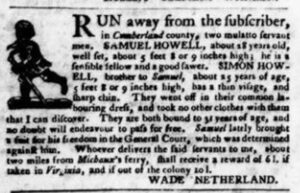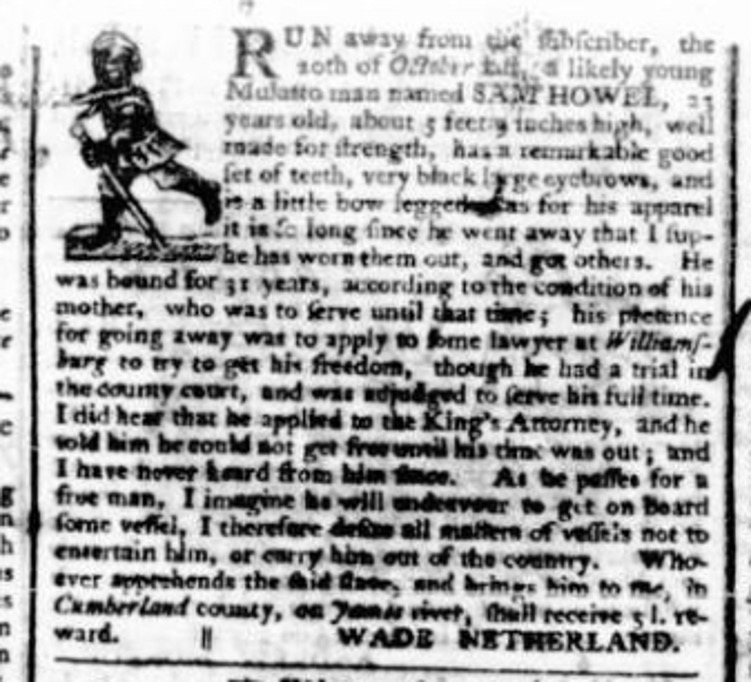Samuel Howell, a mixed-race servant of Wade Netherland of Cumberland County, Virginia, ran away in October of 1765. In the advertisement for his return, published in Purdie & Dixon’s Virginia Gazette the following May, Netherland described Sam as “a likely young Mulatto man . . . 23 years old, about 5 feet 9 inches high, well made for strength, has a remarkable good set of teeth, very black large eyebrows, and is a little bow legged.” Sam was technically not enslaved; he had been bound to serve Netherland until he turned 31, according to the 1705 Virginia law dealing with children of White mothers and Black fathers.[1] His grandmother was Dorothy Howell, also a mixed-race servant who was bound by the same law that was applied to Sam. Dorothy’s mixed-race daughter Lucy, subject to the same law, gave birth to Sam around 1742. This made Sam the fourth-generation descendant of mixed-race females who had formed relationships with Black slaves or servants.[2]
According to Netherland, Sam had run away to Williamsburg to sue for his freedom from the condition imposed by the 1705 law, but the decision went against him. Sam apparently spoke with the King’s Attorney in the colonial capital, who told him that he could not win his freedom, and Netherland surmised that Sam would next try to get aboard a ship to carry him out of Virginia, as many freedom seekers attempted.
Sam returned or was forced to return to Netherland, but in 1769 the determined young man again traveled to Williamsburg seeking freedom. There he found a young Thomas Jefferson, recently admitted by the Virginia bar two years earlier, who agreed to argue his case for no fee before the General Court. Although his notes mention nothing about Sam’s appearance, he may have appeared to Jefferson as a white man unlawfully bound. His argument was that Sam was free, as the 1705 law “subjected to servitude the first mulatto only. That this did not, under the law of nature, affect the liberty of the children. Because, under that law we are all born free.”[3] He then dismissed a 1723 Virginia statute that held that the children of a mulatto bound in service were also bound until the age of 31, reasoning the 1723 statue was unnecessary if the 1705 law applied.[4] In short, Jefferson argued that the law only pertained to the children of the first mixed-race servant, not the grandchildren. Jefferson’s detailed argument did not prevail; the court pre-emptively ruled against him, without even hearing from Jefferson or the opposing lawyer George Wythe.[5] In an 1815 letter to Francis Grey Jefferson offered his mature opinion, using a mathematical formula to argue that third-generation mixed-race people were white and if emancipated became free white citizens. In Sam’s case, since he was not enslaved and met the criteria for being white, according to Jefferson he should be immediately freed.[6]

Unfortunately for Sam, Jefferson’s opinion did not prevail. Disappointed a second time, Sam along with his brother Simon promptly absconded again. His subsequent fate is unknown, although if he was recaptured it is likely that additional years were added to his term of service.
View References
[1] “An Act Concerning Servants and Slaves,” (1705), in William Waller Henning, ed., The Statues at Large; Being a Collection of all the Laws of Virginia… (Philadelphia: R. and W. and G. Bartow, 1823), III, 453.
[2] Paul Heinegg, Free African Americans of North Carolina, Virginia, and South Carolina: From the Colonial Period to about 1820, Vol. I, 4th ed. (Baltimore: Clearfield, 2002), “Howell Family,” 496-9.
[3] Thomas Jefferson, “Thomas Jefferson’s Argument in Howell v. Netherland (1770)” in Encyclopedia Virginia. https://encyclopediavirginia.org/primary-documents/thomas-jeffersons-argument-in-howell-v-netherland-1770 [accessed April 21, 2025].
[4] “An Act directing the trial of Slaves, committing capital crimes; and for the more effectual [punishing conspiracies and insurrections of them; and for the better government of Negros, Mulattos, and Indians, bond or free,” (1723), in William Waller Henning, ed., The Statues at Large; Being a Collection of all the Laws of Virginia… (Philadelphia: R. and W. and G. Bartow, 1823), IV, 133.
[5] For more on this case see Annette Gordon-Reed, “Logic and Experience: Slavery, Race and Thomas Jefferson’s Life in the Law,” in Slavery and the American South : Essays and Commentaries ed. Winthrop Jordan (Jackson: University Press of Mississippi, 2003).
[6] See Thomas Jefferson to Francis C. Gray, March 4, 1815, in Founders Online, https://founders.archives.gov/documents/Jefferson/03-08-02-0245 [accessed April 17, 2025].
